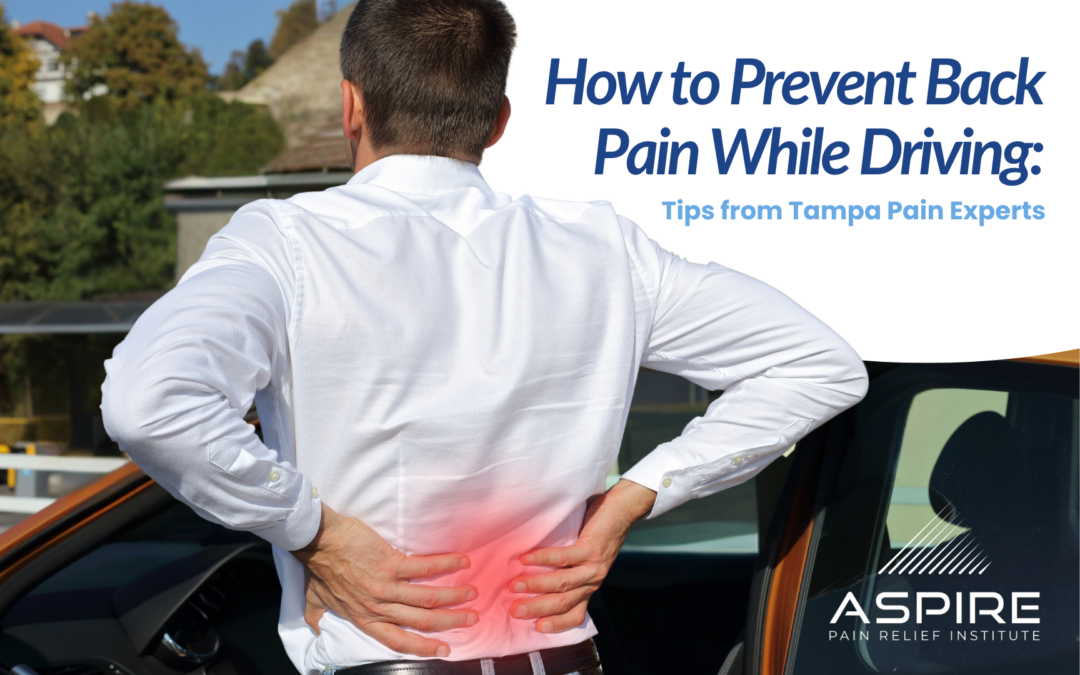Have you experienced back pain while driving? Sitting in the same position for a long period of time can take a toll on your back, leading to chronic pain issues. Fortunately, there are steps you can take to reduce pain and elevate comfort during drives. At our Tampa pain management clinic, we offer personalized solutions that deliver long-term relief. Let’s take a closer look at what causes pain while driving and how our team can help you.
Why Long Drives Can Cause Back Pain
If you’ve ever gotten out of your car and immediately felt pain, you’re not alone. It’s fairly common to get lower back pain from driving, especially after a long commute. Here are some top reasons that you might feel pain:
- Poor posture: Many people slouch while driving, which exerts pressure on the lower back muscles and spine.
- Prolonged sitting: Remaining in the same seated position for a long time causes stiffness and strains the lower back.
- Improper seat position: Seats that are reclined too much or situated too far from the steering wheel won’t properly support your back and spine.
- Road impact: Driving on bumpy roads can stress your local back. Even if the roads are relatively smooth, you may still feel vibrations that cause pain.
- Repetitive movements: Common driving actions, such as reaching for the pedals, turning the steering wheel or shifting gears, can strain your lower back muscles.
How to Minimize Back Pain While Driving
There’s no doubt that driving can be a pain in the back—both literally and figuratively. However, there are ways to help minimize pain and protect your spine during long trips. Here are some top strategies:
- Stretching exercises: Stretching before driving helps keep your muscles flexible and reduces tension in your lower back. Be sure to stretch your hamstrings, hip flexors and lower back muscles.
- Optimize positions: To promote spinal alignment, adjust your seat so that your knees are slightly lower than your hips and your back is fully supported. The seat should also be close to the steering wheel, so that you can comfortably reach it without slouching or stretching too much.
- Maintain proper posture: When driving, try to maintain a straight posture. This involves keeping your back upright, your head aligned with your spine and your shoulders relaxed. Avoid slumping forward or leaning to the side.
- Take breaks: Taking breaks can improve circulation and mobility while reducing muscle fatigue and stiffness. If possible, try to take a short break every two hours or so.
Aftercare: Post-Drive Tips for Back Pain Relief
In addition to the aforementioned tips, it’s a good idea to practice aftercare. Here are some strategies to try after your drive:
- Stretch immediately: As soon as you exit the car, perform gentle stretches that target your lower back, core, hips and legs.
- Apply heat or cold: If your back feels sore, applying a heat pack can relax tight muscles. Cold packs, meanwhile, reduce inflammation. Alternating between the two helps target both stiffness and swelling.
- Move gradually: Avoid jumping straight into strenuous activities. Instead, ease yourself back into things by moving gradually at first.
Visit Aspire Pain Relief Institute for Persistent Back Pain
Many people experience relief after implementing better driving practices and aftercare procedures. Others, however, continue to experience persistent back pain that negatively impacts quality of life. In these cases, you may need professional intervention.
At Aspire Pain Relief, we offer board certified physicians who specialize in high-quality, minimally invasive treatments. We identify the underlying cause of your pain, allowing us to treat pain at its source. Our dedication to compassionate, patient-centered care sets our Tampa pain management clinic apart from the crowd. Schedule an appointment today!

